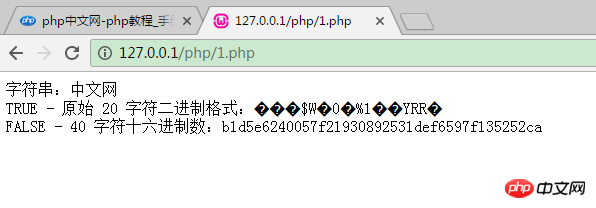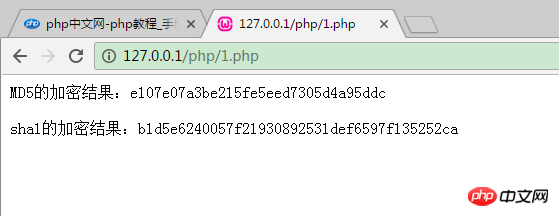 Backend Development
Backend Development
 PHP Tutorial
PHP Tutorial
 PHP encryption function—Instance usage of sha1() function encryption
PHP encryption function—Instance usage of sha1() function encryption
PHP encryption function—Instance usage of sha1() function encryption
PHP encryption function—sha1() function encryption
First of all, let’s introduce what sha1 is?
The full name of sha is: Secure Hash Algorithm (Secure Hash Algorithm) is mainly applicable to the Digital Signature Algorithm DSA defined in the Digital Signature Standard (Digital Signature Standard DSS). For messages less than 2^64 bits in length, SHA1 produces a 160-bit message digest. When a message is received, this message digest can be used to verify the integrity of the data. During the transmission process, the data is likely to change, and different message digests will be generated at this time. The sha1() function provided by PHP uses the SHA algorithm!
In the two articles introduced before, "PHP encryption function—crypt() function encryption" and "PHP encryption function—md5() function encryption", I believe it Everyone has a certain understanding of encryption. In this chapter, we will continue to introduce the sha1() function algorithm, which is similar to the MD5() function.
The syntax format of the sha1() function is as follows:
string sha1 ( string $str [, bool $raw_output = false ] )
| Parameters | Description |
| string | Required. Specifies the string to be calculated. |
| raw | Optional. Specifies hexadecimal or binary output format: TRUE - raw 20-character binary format FALSE - default. 40-character hexadecimal number |
The function returns a 40-digit hexadecimal number. If the parameter raw_output is true, then a 20-digit binary number will be returned. , the default is raw_output is false.
Here we would like to emphasize that the 1 after
sha is the 1 in Arabic numerals (123456). It’s not the letter l (L). Many people will think of it as a letter, but it is an Arabic numeral. Everyone must pay attention here and don’t make a mistake!
The following is an example of the sha1() function. The specific code is as follows:
<?php
header("Content-Type:text/html; charset=utf-8");
$str = "中文网";
echo "字符串:".$str."<br>";
echo "TRUE - 原始 20 字符二进制格式:".sha1($str, TRUE)."<br>";
echo "FALSE - 40 字符十六进制数:".sha1($str)."<br>";
?>The output result is:

The following example is the result of outputting sha1() and testing it:
<?php
header("Content-Type:text/html; charset=utf-8");
$str = "中文网";
echo sha1($str);
if (sha1($str) == "b1d5e6240057f21930892531def6597f135252ca ")
{
echo "<br>I love 中文网!";
exit;
}
?>The output result is:

The following example is a comparison of MD5 and SHA encryption operations. The specific code is as follows:
<?php
header("Content-Type:text/html; charset=utf-8");
$str = "中文网";
echo "MD5的加密结果:".md5($str)."<br>";
echo "<br>";
echo "sha1的加密结果:".sha1($str)."<br>";
?>The output result is:

The main three data encryption functions in PHP, crypt(), md5() and sha1(), have been introduced. In the following article, we will introduce the PHP encryption library: two extension libraries of Mcrypt and Mhash!
【Related Recommendations】
1. Relevant topic recommendations: "PHP Encryption Function"
2. PHP encryption function—crypt() function encryption usage example
3.PHP encryption function—md5() function encryption usage example
4 .PHP encryption technology video tutorial
The above is the detailed content of PHP encryption function—Instance usage of sha1() function encryption. For more information, please follow other related articles on the PHP Chinese website!

Hot AI Tools

Undresser.AI Undress
AI-powered app for creating realistic nude photos

AI Clothes Remover
Online AI tool for removing clothes from photos.

Undress AI Tool
Undress images for free

Clothoff.io
AI clothes remover

Video Face Swap
Swap faces in any video effortlessly with our completely free AI face swap tool!

Hot Article

Hot Tools

Notepad++7.3.1
Easy-to-use and free code editor

SublimeText3 Chinese version
Chinese version, very easy to use

Zend Studio 13.0.1
Powerful PHP integrated development environment

Dreamweaver CS6
Visual web development tools

SublimeText3 Mac version
God-level code editing software (SublimeText3)

Hot Topics
 1666
1666
 14
14
 1425
1425
 52
52
 1327
1327
 25
25
 1273
1273
 29
29
 1253
1253
 24
24
 PHP and Python: Comparing Two Popular Programming Languages
Apr 14, 2025 am 12:13 AM
PHP and Python: Comparing Two Popular Programming Languages
Apr 14, 2025 am 12:13 AM
PHP and Python each have their own advantages, and choose according to project requirements. 1.PHP is suitable for web development, especially for rapid development and maintenance of websites. 2. Python is suitable for data science, machine learning and artificial intelligence, with concise syntax and suitable for beginners.
 PHP: A Key Language for Web Development
Apr 13, 2025 am 12:08 AM
PHP: A Key Language for Web Development
Apr 13, 2025 am 12:08 AM
PHP is a scripting language widely used on the server side, especially suitable for web development. 1.PHP can embed HTML, process HTTP requests and responses, and supports a variety of databases. 2.PHP is used to generate dynamic web content, process form data, access databases, etc., with strong community support and open source resources. 3. PHP is an interpreted language, and the execution process includes lexical analysis, grammatical analysis, compilation and execution. 4.PHP can be combined with MySQL for advanced applications such as user registration systems. 5. When debugging PHP, you can use functions such as error_reporting() and var_dump(). 6. Optimize PHP code to use caching mechanisms, optimize database queries and use built-in functions. 7
 PHP in Action: Real-World Examples and Applications
Apr 14, 2025 am 12:19 AM
PHP in Action: Real-World Examples and Applications
Apr 14, 2025 am 12:19 AM
PHP is widely used in e-commerce, content management systems and API development. 1) E-commerce: used for shopping cart function and payment processing. 2) Content management system: used for dynamic content generation and user management. 3) API development: used for RESTful API development and API security. Through performance optimization and best practices, the efficiency and maintainability of PHP applications are improved.
 PHP vs. Python: Understanding the Differences
Apr 11, 2025 am 12:15 AM
PHP vs. Python: Understanding the Differences
Apr 11, 2025 am 12:15 AM
PHP and Python each have their own advantages, and the choice should be based on project requirements. 1.PHP is suitable for web development, with simple syntax and high execution efficiency. 2. Python is suitable for data science and machine learning, with concise syntax and rich libraries.
 The Enduring Relevance of PHP: Is It Still Alive?
Apr 14, 2025 am 12:12 AM
The Enduring Relevance of PHP: Is It Still Alive?
Apr 14, 2025 am 12:12 AM
PHP is still dynamic and still occupies an important position in the field of modern programming. 1) PHP's simplicity and powerful community support make it widely used in web development; 2) Its flexibility and stability make it outstanding in handling web forms, database operations and file processing; 3) PHP is constantly evolving and optimizing, suitable for beginners and experienced developers.
 PHP and Python: Code Examples and Comparison
Apr 15, 2025 am 12:07 AM
PHP and Python: Code Examples and Comparison
Apr 15, 2025 am 12:07 AM
PHP and Python have their own advantages and disadvantages, and the choice depends on project needs and personal preferences. 1.PHP is suitable for rapid development and maintenance of large-scale web applications. 2. Python dominates the field of data science and machine learning.
 PHP vs. Other Languages: A Comparison
Apr 13, 2025 am 12:19 AM
PHP vs. Other Languages: A Comparison
Apr 13, 2025 am 12:19 AM
PHP is suitable for web development, especially in rapid development and processing dynamic content, but is not good at data science and enterprise-level applications. Compared with Python, PHP has more advantages in web development, but is not as good as Python in the field of data science; compared with Java, PHP performs worse in enterprise-level applications, but is more flexible in web development; compared with JavaScript, PHP is more concise in back-end development, but is not as good as JavaScript in front-end development.
 PHP and Python: Different Paradigms Explained
Apr 18, 2025 am 12:26 AM
PHP and Python: Different Paradigms Explained
Apr 18, 2025 am 12:26 AM
PHP is mainly procedural programming, but also supports object-oriented programming (OOP); Python supports a variety of paradigms, including OOP, functional and procedural programming. PHP is suitable for web development, and Python is suitable for a variety of applications such as data analysis and machine learning.



